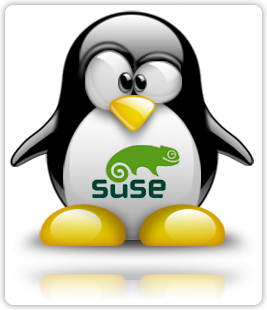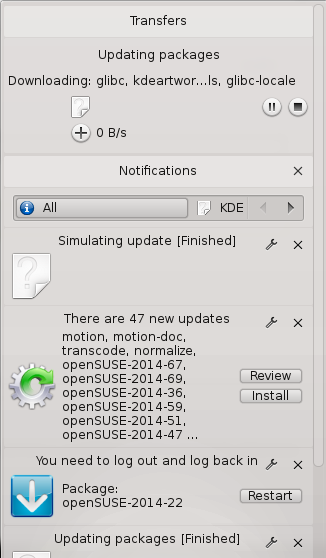openSUSE fans claim it has the best KDE4 implementation, and is an all-around uber-nice distro. Does it? Is it?
Short story for the impatient: openSUSE is a rock-solid Linux distribution with a nice KDE4 implementation and lots of high-end enterprise goodness.
 Most distro reviews go no deeper than a quick look at a live CD/DVD, or a quick tour in a virtual machine, some commentary on the colors, a few screenshots, and done. Linux distro installers have been the best of any operating system for years now, so there is little point in discussing installation, and colors? Is it a mystery that we can change the colors? openSUSE 13.1 was released in November 2013, and I decided to use it for 30 days before reviewing it. Well, time got away from me and here it is nearly 60 days, so it has had a thorough pummeling at my brutal hands.
Most distro reviews go no deeper than a quick look at a live CD/DVD, or a quick tour in a virtual machine, some commentary on the colors, a few screenshots, and done. Linux distro installers have been the best of any operating system for years now, so there is little point in discussing installation, and colors? Is it a mystery that we can change the colors? openSUSE 13.1 was released in November 2013, and I decided to use it for 30 days before reviewing it. Well, time got away from me and here it is nearly 60 days, so it has had a thorough pummeling at my brutal hands.
Not Too Broken
openSUSE is an independent project that receives support from SUSE. SUSE’s development strategy is first stability, then features, then performance. openSUSE is a little different. As Jos Poortvliet (openSUSE’s community manager) puts it, it ships when it’s not too broken. openSUSE doesn’t try to match SUSE’s dedication to perfection, but follows a timed release schedule of a new release every eight months, and a version upgrade every two years. So we’ll get 13.1, 13.2, and 13.3, and then 14.1.
So what does “not too broken” mean in real life? It translates to a good solid distro that you can use for everything from ARM systems to desktops to notebooks to high-demand high-traffic servers.
Bleeding Edge Goodness
openSUSE is a great distro for trying out new technologies. While everyone else is still telling us that Btrfs is not ready for production systems, SUSE Enterprise Linux has supported it since SLES 11 SP2, and it’s also available (though not default) in openSUSE. The Snapper graphical Btrfs manager is a must-have; it works beautifully and makes managing snapshots as easy as falling over. The openQA automated distro build tester is an amazing tool for any distro. This release adds Android device integration in the Dolphin file manager, which is a very cool thing. Because starting with Android 4.0, Ice Cream Sandwich, most Android devices use the MTP (Media Transfer Protocol) to transfer files to a PC, instead of appearing as a generic USB mass storage device. This causes trouble for Linux users because MTP is not installed in most distros by default, though it is in repos. openSUSE 13.1 includes it by default so when you plug in your Android gadget (tablet, phone, Kindle) it automatically shows up in Dolphin.
We also get MariaDB in place of MySQL, OpenStack Havana, Samba 4.1, which is the Active Directory replacement, an experimental KWin Wayland backend, and VLC integration with Phonon. VLC may replace gstreamer as the Phonon backend in 13.2. Both VLC and gstreamer are excellent multimedia frameworks, and in my perfect world it is Phonon that would go away, because for me it gets in the way and it cannot be removed or disabled.
Glitchy Audio and Video
Audio and video were a little weird at first. I kept getting odd pops in the audio between tracks on Pandora and on music CDs. Video did not scroll or redraw smoothly, but rather it hung to the point that it was getting in the way of doing work. Both issues were cured after an update or two and are now nice and smooth.
sudo is Different
If you’re used to how Ubuntu and its derivatives configure sudo, which is to give the default user full privileges and a locked root user account, openSUSE’s handling of sudo might seem a little weird. The openSUSE default is for sudo and su to behave similarly: both need the root password. This is a pointless way to use sudo, so you’ll need to run visudo to set it up correctly. You’ll still need the root password for YaST.
All Users See Your Stuff
openSUSE uses the ancient convention of stuffing all users into the users group, so everything in all home directories are visible to all users. I’ve always thought this is weird, and while YaST lets you choose a different default group there is no option for user private groups. In fact the dropdown list to select a different default group merely shows you all existing groups, which doesn’t help because you don’t want to use any of these as the  default for a human user. So you’ll need to use the
default for a human user. So you’ll need to use the useraddcommand to set up new users instead to give your users their own private groups.
KDE4 Updates Fun
I’ve been a KDE fan since KDE 1.something, way back in the days of pixely graphics. It’s always been complex, and the current versions are great steaming masses of complexity. KDE4’s configuration options and features are legion, so it’s often difficult to tell where a problem originates– is it KDE wigging out, or the underlying distro? Like notifications.
For some reason notifications became a great big important deal to some of the major Linux projects such as Ubuntu, GNOME, and KDE, so they’ve invested a lot of energy into giving every last little process and task a voice. So we get to enjoy all manner of interruptions, rather like baby birds who want something to eat RIGHT NOW. I’ve given up trying to tame the darned things and just turn them off, which is a long and involved process, and it will give me something to click on when I am too old and senile to do much else. Sort of a forever whack-a-mole game. Occasionally they are a little bit useful, and sometimes they’re just plain mystifying, like update notifications (figure 2). The top pane shows progress. Nowhere did it tell me the total size of the downloads, or give an estimated time to completion. Somehow packages are downloaded even though it says 0KB network transfer. It also says I should review the proposed updates, and restart my system now. Magic 8 Ball says just do it and quit bothering me.
Is this a KDE issue? Something weird with openSUSE? Who knows. As long as the updates work I shall content myself with scowling at it occasionally.
The Rest of the Story
There really isn’t much to say. openSUSE works. I have no problems with dependency conflicts, installing and removing all kinds of software including source builds, playing with mass widgets, running gobs of VMs, doing multi-channel audio recording, and video editing without drama. It’s a nice distro with a good responsive community and good documentation. It’s great for KDE fans, and for server admins who want a rich set of advanced enterprise functionality. It is a solid distro that I recommend without reservation.


